To fix magnesium deficiency in tomato plants, use epsom salt as a fertilizer and apply it to the soil.

Credit: extension.sdstate.edu
How to Fix Magnesium Deficiency in Tomato Plants: Step by Step Guide
Nutrient Imbalance In Soil
Soil nutrient imbalance is a common issue that can affect the health and productivity of tomato plants. One specific nutrient deficiency that tomato plants can face is a lack of magnesium in the soil. Magnesium is essential for the proper growth and development of plants, including tomatoes. When the soil has insufficient magnesium levels, it can hinder the absorption of this vital nutrient by tomato plants. Additionally, excessive levels of potassium or calcium in the soil can further hinder magnesium absorption, exacerbating the deficiency issue.
To fix magnesium deficiency in tomato plants, it is important to address the nutrient imbalance in the soil. Conducting a soil test can help determine the exact levels of magnesium and other nutrients, allowing for targeted remedies. One effective solution is to apply magnesium-rich fertilizers or amendments to the soil, helping to replenish the nutrient levels and promote healthy tomato growth.
Plant Inadequacies
Magnesium deficiency in tomato plants can lead to a range of issues, such as poor fruit quality and yield. One common factor contributing to this deficiency is the plant’s inability to efficiently uptake magnesium. This can be influenced by genetic factors, which affect the plant’s ability to absorb and utilize magnesium from the soil.
In order to fix magnesium deficiency in tomato plants, it is important to address these genetic factors. One way to do so is through the selection of tomato varieties that have been bred to have improved magnesium uptake ability. These varieties are specifically developed to overcome the plant’s limitations and ensure efficient absorption of magnesium.
Another approach is to supplement the soil with magnesium-rich fertilizers or amendments. These can provide readily available magnesium for the plants to uptake and prevent or resolve magnesium deficiency. Some popular options include Epsom salts, dolomite lime, and compost.
Additionally, ensuring proper soil pH and moisture levels can also help improve magnesium availability and uptake in tomato plants. Regular soil testing and adjusting pH levels to the ideal range, typically around 6.0-6.5, can promote optimal magnesium uptake.
Overall, addressing the genetic factors affecting magnesium uptake, selecting suitable tomato varieties, and providing adequate magnesium through soil amendments are key steps to fixing magnesium deficiency in tomato plants.
Visual Symptoms
Visual symptoms of magnesium deficiency in tomato plants include yellowing leaves with green veins, brown or red spots on the leaves, and stunted plant growth. The yellowing of leaves with green veins is a common indicator of magnesium deficiency, as the nutrient plays a key role in chlorophyll production. This can result in a lack of pigmentation in the leaves, causing them to turn pale or yellow while the veins remain green.
Brown or red spots on the leaves may also be present, signaling a more severe deficiency. These spots typically appear near the edges of the leaves and can spread inward as the deficiency worsens. Additionally, magnesium deficiency can stunt plant growth, leading to overall weaker and smaller plants.
Soil Testing
A crucial step in fixing magnesium deficiency in tomato plants is soil testing. Soil testing allows you to accurately determine the nutrient levels and identify any deficiencies. One option is to use magnesium deficiency testing kits, which are readily available in the market. These kits provide a convenient and quick way to test for magnesium levels in the soil.
Another approach is to submit soil samples to local agricultural authorities or specialized laboratories. This ensures accurate and comprehensive analysis of the soil, including magnesium levels. By identifying the deficiency, you can take targeted measures to supplement the magnesium in the soil and promote healthy tomato plant growth.
Organic Methods
In order to fix magnesium deficiency in tomato plants, organic methods can be utilized. One effective approach is the application of Epsom salt. Epsom salt, known as magnesium sulfate, is a natural and readily available source of magnesium. To remedy the deficiency, dissolve 2 tablespoons of Epsom salt in 1 gallon of water and apply the mixture to the base of the tomato plants.
Another organic method involves incorporating compost or organic matter that is rich in magnesium into the soil. This can be achieved by adding well-decomposed compost or using organic fertilizers that are specifically formulated with magnesium. By implementing these organic methods, tomato plants can regain the necessary amount of magnesium, which is vital for their overall growth and development.
Fertilization
When it comes to fixing magnesium deficiency in tomato plants, proper fertilization plays a crucial role. The first step is selecting magnesium-rich fertilizers that can effectively address the deficiency. Look for fertilizers that contain a high percentage of magnesium. Pay attention to the labeling to ensure the fertilizer is specifically formulated for plants requiring magnesium.
Once you’ve selected the right fertilizer, it’s important to follow appropriate application rates and methods. Overdosing can be harmful to the plants, so it’s essential to apply the fertilizer according to the recommended dosage. Be sure to evenly distribute the fertilizer around the base of the tomato plants, taking care to avoid direct contact with the stems or leaves. Depending on the fertilizer type, you may need to mix it with water before applying.
Regularly monitor the plants for any signs of improvement or continued deficiency. Adjust the fertilization schedule if necessary to provide ongoing magnesium support to the tomato plants. By following these guidelines, you can fix magnesium deficiency and ensure the healthy growth of your tomato plants.
Foliar Spray
One effective method for fixing magnesium deficiency in tomato plants is through the use of foliar sprays. Foliar sprays are solutions that are directly applied to the leaves of the plants, allowing for quick absorption and utilization of nutrients. When preparing a magnesium-rich foliar spray, it is important to select a suitable magnesium source such as Epsom salts or a magnesium-specific fertilizer. The timing and frequency of application are crucial factors to consider.
It is generally recommended to apply foliar sprays in the morning or late afternoon to avoid excessive evaporation. As for the frequency, spraying the tomato plants every two weeks during the growing season is a typical recommendation. However, it is crucial to closely monitor the plants and adjust the frequency according to their specific needs. Regular foliar sprays can provide the necessary magnesium to overcome deficiencies and promote healthy tomato plant growth.
Frequently Asked Questions For How To Fix Magnesium Deficiency In Tomato Plants
How Do I Add Magnesium To My Tomato Plants?
To add magnesium to tomato plants, mix Epsom salt with water and apply it to the soil.
How Do You Fix Magnesium Deficiency In Tomatoes?
To fix magnesium deficiency in tomatoes, apply Epsom salt directly to the soil around the plants and water thoroughly.
What Is The Best Source Of Magnesium For Tomatoes?
The best source of magnesium for tomatoes is Epsom salt, which provides a quick and effective way to boost plant growth and fruit production.
Can A Plant Recover From Magnesium Deficiency?
Yes, a plant can recover from magnesium deficiency with proper treatment and nutrient replenishment.
Conclusion
Fixing magnesium deficiency in tomato plants is crucial to ensure their healthy growth and abundant yield. By understanding the symptoms and causes of magnesium deficiency, gardeners can take effective measures to rectify the issue. The first step is to conduct a soil test to determine the level of magnesium in the soil.
Based on the results, appropriate amendments such as Epsom salt or compost rich in magnesium can be added to the soil. Furthermore, maintaining proper watering practices, avoiding over-fertilization, and regular monitoring of plants can help prevent magnesium deficiency in the long run.
Remember that prevention is always better than cure, so it is important to create a balanced nutrient environment for tomato plants right from the beginning. By following these simple steps, gardeners can ensure their tomato plants receive adequate magnesium and thrive in optimal conditions.
Happy gardening and happy harvesting!

